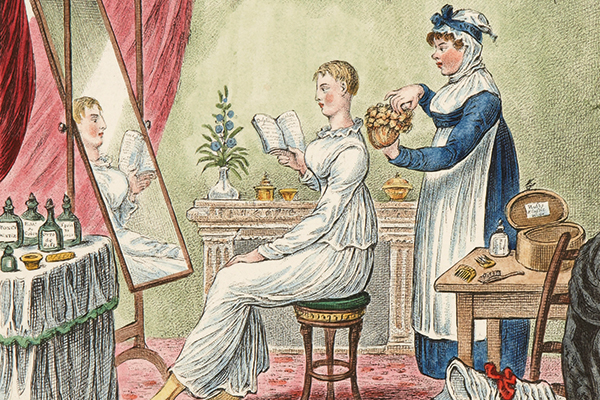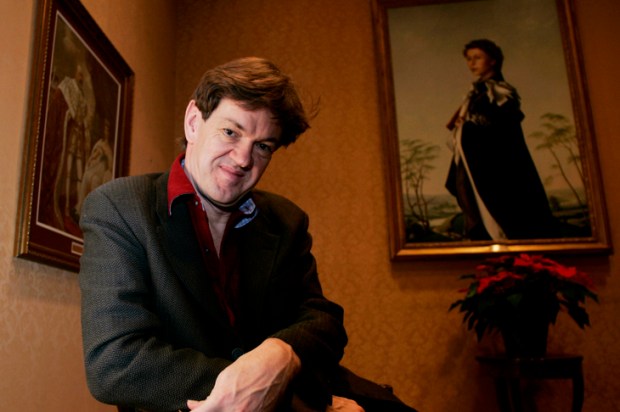‘I have nothing to doe but work and read my Eyes out,’ complained Anne Vernon in 1734, writing from her country residence in Oxfordshire to a friend in London. She and her circle of correspondents (who included Mary Delany, the artist and bluestocking) swapped rhyming jokes, ‘a Dictionary of hard words’, and notes on what they were currently reading. Their letters are suggestive of the boredom suffered by women of a certain class, constrained by social respectability and suffering the restlessness of busy but unfulfilled minds.
But that’s not their interest for Abigail Williams in this fascinating study of habits of reading in the Georgian period. Her quest is rather to discover how they read, in which room of the house, who with, out loud or alone and silently, as entertainment or education. A professor of English literature at Oxford University, she has turned her attention away from the content of books to focus on the ways in which that content is received and appreciated.
How books are read is as important as what’s in them, argues Williams persuasively, and her book charts her exhaustive forays into a multiplicity of sources, reading between the lines of diaries, letters and library records to glean an understanding of ‘what books have meant to readers in the past’. It has long been thought, for instance, that the print revolution of the 18th century resulted in a shift from oral to silent reading, from shared reading to indulging in a book of one’s own, as books became more available to a wider range of people while leisure time also increased. But, says Williams, such a clear-cut transition is difficult to trace.
On the contrary, reading aloud remained as popular as it had ever been because it was sociable and gave participants a glancing acquaintance with books that might otherwise take weeks to read (such as Samuel Richardson’s five-volume novel Clarissa or be beyond the budget of a housemaid or stonemason. Sharing of books and communal reading staved off the boredom of long, dark winter nights while at the same time providing opportunities for self-improvement. (The Margate circulating library, we discover, had 600 sermons in its collection.)
 ‘Tales of Wonder’ by James Gillray
‘Tales of Wonder’ by James Gillray
Reading out loud was also encouraged as a defence against the ‘seductive, enervating dangers’ of sentimental novels, and the ‘indelicacy’ of certain plays. Like the nine o’clock watershed or the internet filter, suggests Williams, reading in company was an attempt to ensure that young people were not corrupted by too much acquaintance with writers like Shakespeare. Thomas Bowdler’s Family Shakespeare, subtitled ‘in Which Nothing is Added to the Original Text but those Words and Expressions are Omitted Which Cannot with Propriety be Read Aloud in a Family’, was extremely popular in spite of, or rather because, ‘objectionable expressions’ and ‘redundant’ passages had been removed.
We might think our multimedia habits of channel-surfing while reading Twitter and replying to emails are evidence of our advanced 21st-century brain capacity and powers of attention amid chaotic busyness. But here we find Mary Delany recommending James Boswell’s Tour of the Hebrides as an excellent book to listen to while doing knotting work. Hairdressing and powdering in this age of wigs was often a good time to catch up on the latest novel — the bindings of books once owned by circulating libraries are often ‘cracked by quantities of powder, and pomantum between the leaves’. Servants, too, were often part of the reading experience, Hester Thrale noting in her diary that her maid listened in while she read from the original Spectator to her daughters.
Not only were abridged collections, such as Bowdler’s edition, produced to satisfy the demand for plays that could be staged at home (illustrated costume suggestions and acting directions were often included), but also shortened versions of novels were printed in magazines, in serial form, as folded pamphlets, while favourite scenes and passages were collected into volumes of ‘Beauties’ (75 per cent of the surviving copies of Robinson Crusoe are abridgements). At the same time Spouting Clubs emerged, where tradesmen and merchants could practise reading verses and passages from books following the advice of newly published books on elocution and delivery: ‘The Mouth should not be writh’d, the Lips bit or lick’d, the Shoulders shrugg’d, nor the Belly thrust out.’
On 1 July 1780 Anna Larpent read from four different books in a single day with four different people. None of them will have heard more than a small portion of the whole book. Sampling, excerpting, reading again were common practice as readers moved between different genres. But Williams begins by quoting from the journal of Dorothy Wordsworth, who after that famous afternoon walk in April 1802 when she and her brother came upon the daffodils dancing in the breeze later went into a tavern for refreshment. There, she and William found a pile of books and spent the rest of the day drinking tots of warm rum and reading together from a volume of Congreve — a single journal entry illustrating how poetry was made but also how literature was best enjoyed, impromptu, in company, at leisure.
Got something to add? Join the discussion and comment below.
Get 10 issues for just $10
Subscribe to The Spectator Australia today for the next 10 magazine issues, plus full online access, for just $10.
You might disagree with half of it, but you’ll enjoy reading all of it. Try your first month for free, then just $2 a week for the remainder of your first year.














Comments
Don't miss out
Join the conversation with other Spectator Australia readers. Subscribe to leave a comment.
SUBSCRIBEAlready a subscriber? Log in